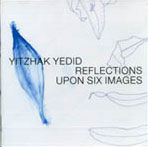Home » Jazz Articles » Bailey's Bundles » A New Third Stream: Yitzhak Yedid
A New Third Stream: Yitzhak Yedid
Starting with Charlie Parker With Strings (Verve), its various editions featuring tracks recorded 1947-1952, a trend emerged where frontline instrumentalists found it quite the accomplishment to record a "with strings album—notable examples include trumpeter Chet Baker and saxophonists Art Pepper, Stan Getz and Jim Snidero.
But the use of strings does not in itself make for third stream jazz. In the 1950s more serious experimentation was made, most particularly by Schuller. But the results were still unfinished torsos of art. Rather than continuing in this direction, jazz veered into the avant-garde and found a soul mate in much 20th Century classical music. It is this eutection that Israeli pianist and composer Yitzhak Yedid hones in on and develops. Yitzhak Yedid
Yitzhak Yedid
Myth Of The Cave
Between The Lines
2003
The Myth Of The Cave is a calming salve. It is music with the spirit of Jimmy Giuffre's trio recordings Free Fall (Columbia, 1962), Emphasis, Stuttgart 1961 (hatART), and Flight, Bremen 1961 (hatART) without the same degree of improvisation. Yedid's compositions making up Myth are just that: compositions. They are not spontaneous improvisations, though some improvisation is included.
Yedid's care in the concept and execution of this music is obvious in the way its sharp edges are softened and its angular elements smoothed, and his work compares well with modern composer Morton Feldman's clarinet music. Both composers produce spatially constructed compositions with much strategically placed white space. This aesthetic, coupled with the complexly conceived (both musically and metaphorically) movements, together create and shape Myth. Yedid and clarinetist Francois Houle produce a soothing environment that is floated above bassist Ora Boasson-Horev's ethereal foundation. This is music of peace and quiet.
 Yitzhak Yedid
Yitzhak Yedid
Reflection Upon Six Images
Between The Lines
2004
Reflection Upon Six Images is musically antithetical to Myth Of The Cave. Where Myth is a picture of serenity, Reflection is one of angst and anxiety. This is disquieting music made that much more so by the contributions of violist Galia Hai. The viola is the butt of many jokes in classical music circles, but nevertheless produces a deep melancholic tone that can be coaxed into an expression of madness. These six reflections allow Hai and clarinetist Francois Houle to plumb the musical depths of a belching, sulfurous creative unconscious.
Reflections is a demanding but ultimately rewarding listening experience. I was listening to it for review while reading Elie Wiesel's Auschwitz memoir, Night. The album perfectly conjured up the skeletal landscape described by Wiesel. Yedid produces music that proves that art not need always be appealing, only true. The quartet here more approximates George Crumb's Black Angels (various labels, 1972-2003) looking backwards. This is difficult music to describe, much less understand, but it is important music.
Tracks and Personnel
Myth Of The Cave
Tracks: First Movement-The Crystal Hope; Second Movement-Non Believer's Prayer; Third Movement-Imaginary Ritual; Fourth Movement-Liturgical Sorrow; Fifth Movement-Delusion Reality.
Personnel: Yitzhak Yedid: piano; Francois Houle: clarinet, bass clarinet; Ora Boasson-Horev: bass.
Reflection Upon Six Images
Tracks: First Image; Second Image; Third Image; Fourth Image; Fifth Image; Sixth Image.
Personnel: Yitzhak Yedid: piano; François Houle: clarinet; Galia Hai: viola; Ora Boasson-Horev: bass.
< Previous
A Love Supreme: The Legacy of John Co...
Comments
Tags
For the Love of Jazz
 All About Jazz has been a pillar of jazz since 1995, championing it as an art form and, more importantly, supporting the musicians who create it. Our enduring commitment has made "AAJ" one of the most culturally important websites of its kind, read by hundreds of thousands of fans, musicians and industry figures every month.
All About Jazz has been a pillar of jazz since 1995, championing it as an art form and, more importantly, supporting the musicians who create it. Our enduring commitment has made "AAJ" one of the most culturally important websites of its kind, read by hundreds of thousands of fans, musicians and industry figures every month.


















